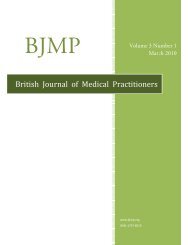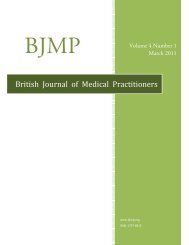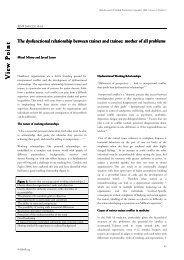R esearch A rticle - British Journal of Medical Practitioners
R esearch A rticle - British Journal of Medical Practitioners
R esearch A rticle - British Journal of Medical Practitioners
You also want an ePaper? Increase the reach of your titles
YUMPU automatically turns print PDFs into web optimized ePapers that Google loves.
<strong>British</strong> <strong>Journal</strong> <strong>of</strong> <strong>Medical</strong> <strong>Practitioners</strong>, March 2013, Volume 6, Number 1<br />
BJMP 2013;6(1):a605<br />
Case Report<br />
Persistent genital arousal disorder in a male: a case report and analysis <strong>of</strong> the cause<br />
Rajkumar Kamatchi and Andrew Ashley-Smith<br />
A 54-year-old male presented to the psychosexual clinic with<br />
symptoms suggestive <strong>of</strong> persistent genital arousal disorder <strong>of</strong><br />
2years duration. Physical examination and investigations ruled<br />
out any underlying urological or neurological causes. He was<br />
treated with Diazepam and Pregabalin and his symptoms<br />
reduced in intensity.<br />
Introduction:<br />
Persistent genital arousal disorder (PGAD), also known as<br />
persistent sexual arousal syndrome (PSAS) or restless genital<br />
syndrome (ReGS), is recently recognised as a sexual health<br />
problem in western countries although it is not been considered<br />
as a physical or psychiatric disorder by DSM IV or ICD 10.<br />
PGAD is associated with constant, spontaneous and intrusive<br />
feelings <strong>of</strong> genital arousal in the absence <strong>of</strong> conscious sexual<br />
thoughts or stimuli.<br />
The working definition <strong>of</strong> PGAD 1 , 2 is as follows:<br />
1) Persistent physical arousal in the genital area<br />
2) in the absence <strong>of</strong> conscious thoughts <strong>of</strong> sexual desire or<br />
interests<br />
3) associated with spontaneous orgasm or feelings that orgasm is<br />
imminent and<br />
4) the symptoms not diminished by orgasm.<br />
It may be present throughout the person’s life (primary PGAD)<br />
or develop at any age (secondary PGAD). It is associated with<br />
varying degrees <strong>of</strong> distress in the patients. This new disorder has<br />
been reported in women by numerous clinicians in the last<br />
decade. However, so far, there is only one report <strong>of</strong> two males<br />
suffering with ReGS in the literature. 3 We report a case <strong>of</strong><br />
PGAD in a male and aim to analyse the cause.<br />
Case Report<br />
A 54-year-old male was referred to the psychosexual clinic by an<br />
urologist with 2 years history <strong>of</strong> constant feelings <strong>of</strong> physical<br />
arousal in the genital area as if he was about to ejaculate. These<br />
feelings were associated with pain which was relieved to an<br />
extent after ejaculation. These symptoms started suddenly for<br />
the first time when he was browsing the internet and<br />
accidentally ended up in pornographic websites. But later on,<br />
the symptoms were constant without any sexual stimuli and he<br />
got some relief from attaining climax.<br />
He described that the physical arousal in the genital area<br />
increased in intensity to a point he had to ejaculate to have<br />
some relief. He felt this “as if wanting to have climax all the<br />
time”. Post- ejaculation, he felt anxious, tired and nauseated for<br />
sometime, during which the symptoms intensified again that he<br />
needed climax. Initially this cycle repeated every 2-3 days but<br />
later on the frequency increased to 2-3 times a day. He achieved<br />
climax both by masturbation and sexual intercourse. He felt<br />
these ejaculations were unpleasant and not enjoyable. He felt<br />
frenzied if he couldn’t ejaculate and the post orgasmic feelings<br />
were severe if he avoided orgasm for a day or two. He described<br />
regular ejaculations led to less severe “come downs” but left him<br />
constantly drained.<br />
His medical history included vasectomy four years ago with<br />
minor complication <strong>of</strong> painful scrotum which subsided fully<br />
with pain killers. He also had few urinary tract infections (UTI)<br />
in the past which were treated with antibiotics. He was initially<br />
seen by urologist who carried out physical examination which<br />
was noted to be normal. Then investigations including CT-<br />
KUB, CT- Abdomen, Urogram, Transrectal Ultrasound <strong>of</strong><br />
prostate and seminal vesicles, Flexible Cystoscopy were done<br />
and no abnormalities noted. He also had MRI- Brain which<br />
was normal. He had no symptoms <strong>of</strong> hyperactive bladder and<br />
no varicocele was noted.<br />
When he was seen in the psychosexual clinic, he was noted to<br />
be very anxious and expressed guilty feelings around the<br />
incident <strong>of</strong> watching pornography which initiated the onset <strong>of</strong><br />
symptoms. There were no depressive or psychotic symptoms.<br />
Prior to attending this clinic he was prescribed duloxetine<br />
30mgs by the urologist, which he took only for few weeks. He<br />
stopped it as there was no symptom relief. He was started on<br />
diazepam and pregabalin. The dose was increased to 2mgs qds<br />
<strong>of</strong> diazepam and 50mgs qds <strong>of</strong> pregabalin. His symptoms<br />
diminished gradually and now he remains mildly symptomatic<br />
although feeling “more in control”. He was also referred to<br />
psychologist and had an assessment. As he was not<br />
BJMP.org<br />
30







